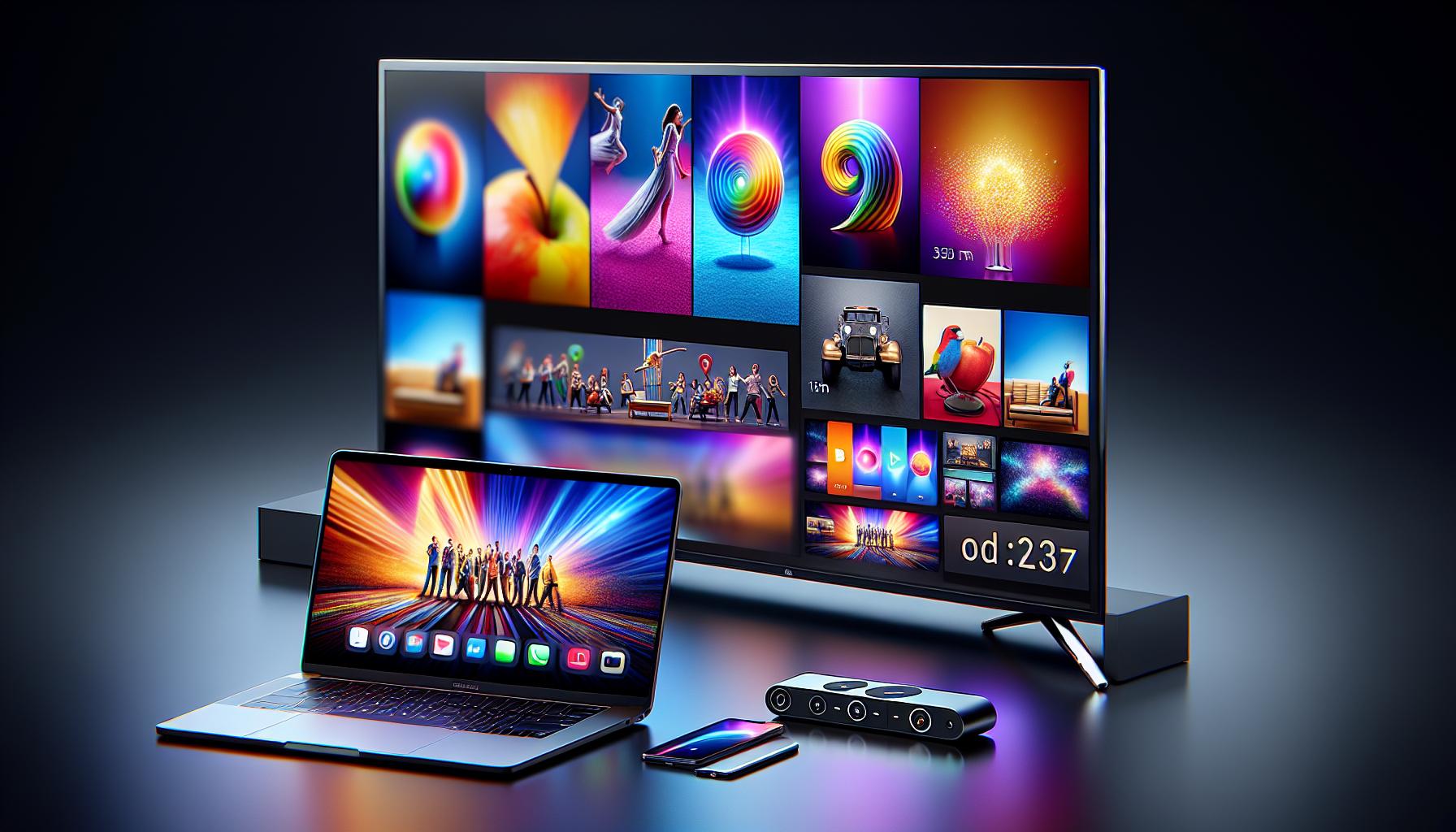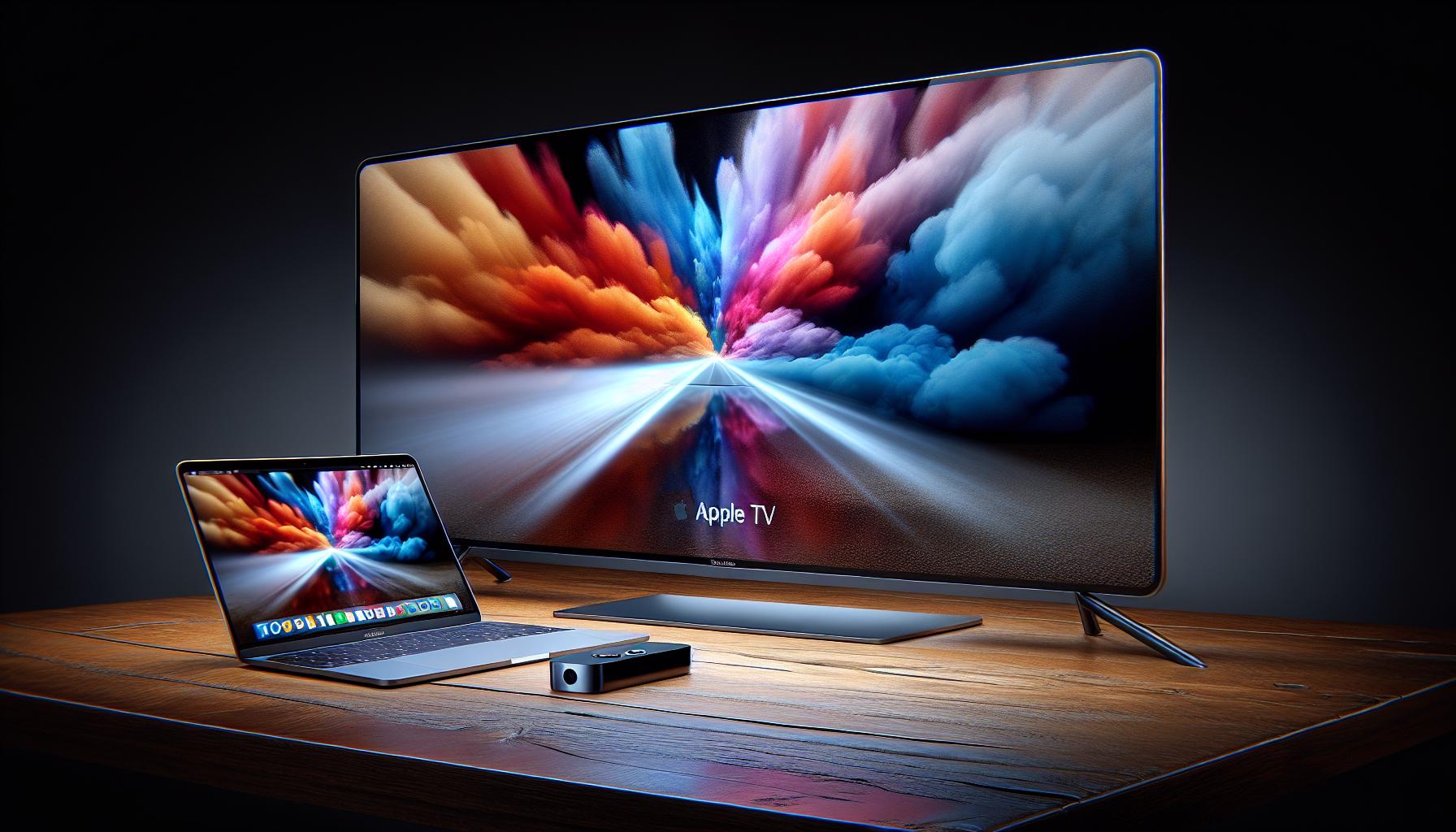Ever wished you could share your MacBook screen on a bigger platform? Maybe you're trying to show off those vacation photos, or you've got a presentation that'd look better on a larger screen. Well, you're in luck! Apple's got a built-in feature just for that.
With AirPlay, you can mirror your MacBook screen right onto your Apple TV. It's simple, quick, and requires no additional hardware. So whether it's for work or play, sit back and let us guide you through the process of mirroring your MacBook to your Apple TV.
What is AirPlay?
Before delving into the details of how to mirror your MacBook to Apple TV, it's essential to understand AirPlay. AirPlay is an exclusive, proprietary technology developed by Apple. It allows you to wirelessly stream a wide variety of media, including videos, music, photos, and even screen mirroring, from an Apple device to an AirPlay-enabled device.
Here's a clearer picture: Imagine wirelessly streaming your favorite Netflix show from your iPhone directly onto your large TV screen. Or perhaps you're eager to share the latest photos from your vacation on your iPad with the entire family huddled around the TV. These flawless, wireless streaming sessions are made possible due to AirPlay.
When it comes to screen mirroring, AirPlay takes it to the next level. It lets you project your MacBook screen onto an AirPlay-compatible device, such as an Apple TV. This feature can be a game-changer when you're looking to showcase a presentation, share a slide show, or even if you're just seeking a larger screen for a more immersive gaming or movie watching experience.
Despite this, many people aren't making full use of this innovative feature. You could be one of them. But don't sweat it, we’re about to guide you through the process of using AirPlay to mirror your MacBook screen to Apple TV. Just imagine how impressive it would feel to operate your MacBook from your TV screen. Stay tuned and start experiencing the technological magic that is AirPlay.
For more specific instructions on how to use AirPlay, keep reading.
Next Section: Your Step-by-step Guide to Mirroring MacBook to Apple TV with AirPlay.
Benefits of Mirroring Your MacBook to Apple TV

Enhanced Visual Experience jumps off as the first benefit. With AirPlay, your MacBook's screen isn't constrained by size anymore. Streaming to your Apple TV allows for a larger, more immersive visual experience. It'll be like transforming your TV into a giant MacBook screen!
Ease of Presentation and Collaboration also shines as a major advantage. Whether you're displaying your latest work project, a school presentation, or your newly edited photo or video, AirPlay provides you the luxury of a bigger canvas. Sharing content with a group becomes much more straightforward and enjoyable.
Imagine, streaming a virtual tour on Zoom or Google Meet right off your MacBook onto your Apple TV. Showcasing your presentation on the big screen makes it easier for everyone to engage. The entire room gets to participate actively, ensuring productive collaborations.
Diversified Entertainment Options open up when you exploit the potential of AirPlay mirroring on your MacBook. Your Apple TV suddenly becomes your gateway to a broader array of multimedia content. Now, you're not limited to the apps specific to your TV. Dive into your macOS's bigger app library. Stream a wider selection of games, movies, series, and music right from your laptop.
AirPlay not only mirrors your screen but can also amplify your MacBook's audio output. So, next time you're in the mood for a HouseParty or a blasting playlist, remember you've got your very own concert setup!
Portability and Comfort come to fore as the unsung heroes of AirPlay. Your MacBook coupled with an Apple TV empowers you to carry your multimedia hub wherever you go. Be it your living room, bedroom, or even the backyard, your favorite content always follows!
For your next step, you'll unravel the 'how to' of mirroring your MacBook to Apple TV. Don't worry, you've got a step-by-step guide to walk you through the process. Stick around.
Requirements for Mirroring Your MacBook to Apple TV
Before you can enjoy the benefits of AirPlay, there's a set of requirements your devices must meet.
Firstly, ensure you've got an Apple TV that's second generation or newer. Older models lack the necessary AirPlay functionality. Given that technology's moved apace since Apple first introduced these devices, chances are you've got a compatible version.
Your MacBook also plays a role in this equation. You need a Mac running Mountain Lion (OS X 10.8) or later. If you're not sure whether your MacBook fits the bill, don't fret. Here's a list of all macOS versions that support AirPlay:
- Yosemite (10.10)
- El Capitan (10.11)
- Sierra (10.12)
- High Sierra (10.13)
- Mojave (10.14)
- Catalina (10.15)
- Big Sur (11)
Now let's talk about your internet connection. To mirror your MacBook, both your Apple TV and your MacBook need to be on the same Wi-Fi network. Ethernet connections won't enable the feature.
Lastly, software updates. Keeping your devices updated enhances their performance and ensures compatibility. Ensure both your Apple TV and MacBook have the latest software updates installed.
You're well on your way to turning your living room into a professional workspace or entertainment hub. Now that you understand the prerequisites, you're ready to begin the actual process of setting up AirPlay. Providing your devices tick all these boxes, let's move to the next section.
Step-by-Step Guide to Mirroring Your MacBook to Apple TV
You've ensured both your MacBook and Apple TV are compliant with all necessary requirements. Now, it's time to delve deeper into the step-by-step guide for mirroring your MacBook screen to Apple TV.
Step 1: Enable AirPlay on Apple TV
First up, make sure to enable AirPlay on your Apple TV. Navigate to the "Settings" menu, from there, click on "AirPlay". Here you need to make sure AirPlay is set to "On".
Step 2: Connect MacBook and Apple TV to the Same Wi-Fi
Remember, your Apple TV and MacBook must connect to the same Wi-Fi network. This step is crucial for successful screen mirroring.
Step 3: Enable Screen Mirroring on Your MacBook
Next, let's turn your attention to your MacBook. There, in the menu bar, find the "AirPlay Video" option and click on it. Now you should see all the AirPlay enabled devices, pick your Apple TV from that list.
Step 4: Choose the Screen Mirroring Option
In the subsequent dropdown menu, choose "Mirror Built-in Display". Additionally, you can adjust the screen resolution to best fit your viewing experience.
And voila! Your MacBook’s screen should now appear on your TV. From videos and photos to presentations, you can now enjoy big-screen viewing directly from your MacBook.
Should you want to end the screen mirroring, just return to the "AirPlay Video" in the menu bar of your MacBook, and simply select "Turn AirPlay Off".
Tips and Troubleshooting for Mirroring Your MacBook to Apple TV

Now that you've successfully mirrored your MacBook's screen to your Apple TV, it's time to enhance your experience. The focus here will not only be on enhancing user experience, but we'll also troubleshoot some common issues that you might face.
First off, experience enhancement is important when mirroring. You want to make sure the mirrored screen is as sharp and crisp as possible. To achieve a top-notch viewing experience:
- Make certain your Apple TV's resolution matches that of your MacBook. The match ensures crystal clear quality.
- Avoid multitasking on your MacBook. Mirroring tends to use a significant chunk of CPU power. You'll garner a smoother streaming experience when you focus solely on the content you're mirroring.
Let's turn our focus toward troubleshooting. Despite following all the steps you could face some huddles while mirroring. Here are some common issues and their resolutions:
- Slow and Choppy Streaming: Make sure nothing is bogging down your Wi-Fi network. If many devices are connected, disconnect a few. Hint: Wired connections generally offer more stable streaming than wireless ones.
- Unable to Connect: If you can't seem to establish a connection, double-check and make sure both devices are on the same Wi-Fi network.
- Mirroring Not Available: Occasionally, your MacBook might fail to detect the Apple TV. In this case, restart both devices and try again.
Understanding these tips and troubleshooting the aforementioned issues will undoubtedly improve your screen mirroring experience. After all, the critical note is to enjoy your big-screen viewing to the fullest. Stay tuned for more insights on how to effectively use Apple devices and services.
Conclusion
You've now got the know-how to mirror your MacBook to your Apple TV like a pro. Remember, it's all about getting both devices on the same Wi-Fi network and enabling AirPlay. Don't forget that adjusting your resolution can enhance your viewing experience. If you run into any hiccups, you've got troubleshooting tips at your fingertips. So, go ahead and enjoy that big-screen experience. Remember, your MacBook and Apple TV are more than just devices, they're gateways to a world of visual enjoyment. Stay tuned for more insights and tips on making the most of your Apple devices. Happy mirroring!
Frequently Asked Questions
How can I mirror my MacBook screen to my Apple TV using AirPlay?
You must first enable AirPlay on your Apple TV, then make sure both your MacBook and Apple TV are connected to the same Wi-Fi network. After this, you can enable screen mirroring on your MacBook and select the Apple TV you want to mirror to.
How can I enhance my screen mirroring experience?
Try to match the resolution of your Apple TV to your MacBook for better quality. Also, avoid multitasking on your MacBook while mirroring as it can slow down the streaming speed.
What are some common troubleshooting tips for screen mirroring issues?
Ensure both devices are on the same Wi-Fi network. If streaming is slow, attempt to close any unnecessary applications on your MacBook. If mirroring is not available, try restarting both devices.
What are the benefits provided by this article?
The article provides a concise and clear step-by-step guide on screen mirroring. It also provides tips to enhance your viewing experience and solutions for common issues you might encounter while using AirPlay.




